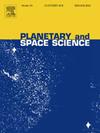The chemistry and mineralogy of the LX high-fidelity lunar regolith simulants
IF 1.7
4区 物理与天体物理
Q3 ASTRONOMY & ASTROPHYSICS
引用次数: 0
Abstract
To support sustainable solar system exploration, humans must harness resources from celestial bodies like the Moon to build infrastructure and obtain essential consumables, including water and oxygen. Lunar regolith, a loose rock layer covering the Moon’s surface, is a key resource for in-situ resource utilisation (ISRU) technologies. Developing and testing these technologies on Earth relies on the use of accurate simulant materials. In prior studies, the LX lunar regolith simulant system was developed and the base simulants LX-T100 (anorthosite) and LX-M100 (basalt) were thoroughly characterised in terms of their bulk mineralogical and bulk chemical composition, particle size distribution, particle morphology, density, void ratio and porosity, adsorption and BET-specific surface area, compressibility, flow, magnetic and optical properties. This work focuses on the LX high-fidelity simulants, specifically their mineralogy and chemistry. The high-fidelity simulants are composed of four source rocks, namely the anorthosite of LX-T100, the basalt of LX-M100, as well as a harzburgite as a source for olivine and pyroxene and an ilmenite ore as a source for ilmenite. The bulk mineralogy and chemistry of the harzburgite and ilmenite ore, as well as the crystal chemistry of all four source rocks, were analysed and the results were compared with the lunar samples from the Apollo and Luna missions. Finally, a deviation analysis was carried out in which the bulk chemistry of the LX high-fidelity simulants and 13 other relevant simulants from research and industry were compared with the chemical composition of the lunar soil at the landing sites of the Apollo, Luna and Chang’e 5 missions. It was shown that of all simulants, the LX high-fidelity simulants can on average best mimic the chemical composition of the lunar soil. The findings from these investigations deepen the understanding of the LX lunar regolith simulants, increasing their reliability for scientific research.
LX高保真月球风化模拟物的化学和矿物学
为了支持可持续的太阳系探索,人类必须利用月球等天体的资源来建设基础设施,并获得必要的消耗品,包括水和氧气。月球风化层是覆盖在月球表面的松散岩层,是原位资源利用(ISRU)技术的关键资源。在地球上开发和测试这些技术依赖于使用精确的模拟材料。在之前的研究中,我们开发了LX月球风化层模拟体系,并对LX- t100(斜长岩)和LX- m100(玄武岩)的基础模拟物进行了全面表征,包括它们的总体矿物学和总体化学组成、粒度分布、颗粒形态、密度、空隙比和孔隙度、吸附和bet比表面积、可压缩性、流动性、磁性和光学性质。这项工作的重点是LX高保真模拟,特别是它们的矿物学和化学。高保真模拟物由LX-T100的斜长岩、LX-M100的玄武岩、作为橄榄石和辉石来源的辉石石和作为钛铁矿来源的钛铁矿组成。研究人员分析了黑锰矿和钛铁矿矿石的总体矿物学和化学成分,以及所有四种烃源岩的晶体化学成分,并将结果与阿波罗和月球任务的月球样本进行了比较。最后,将LX高保真模拟物和其他13个研究和工业相关模拟物的整体化学成分与阿波罗、月球和嫦娥5号登月任务着陆点的月球土壤化学成分进行了偏差分析。结果表明,在所有模拟模型中,LX高保真模拟模型平均能最好地模拟月球土壤的化学成分。这些调查结果加深了对LX月球风化模拟装置的理解,提高了它们在科学研究中的可靠性。
本文章由计算机程序翻译,如有差异,请以英文原文为准。
求助全文
约1分钟内获得全文
求助全文
来源期刊

Planetary and Space Science
地学天文-天文与天体物理
CiteScore
5.40
自引率
4.20%
发文量
126
审稿时长
15 weeks
期刊介绍:
Planetary and Space Science publishes original articles as well as short communications (letters). Ground-based and space-borne instrumentation and laboratory simulation of solar system processes are included. The following fields of planetary and solar system research are covered:
• Celestial mechanics, including dynamical evolution of the solar system, gravitational captures and resonances, relativistic effects, tracking and dynamics
• Cosmochemistry and origin, including all aspects of the formation and initial physical and chemical evolution of the solar system
• Terrestrial planets and satellites, including the physics of the interiors, geology and morphology of the surfaces, tectonics, mineralogy and dating
• Outer planets and satellites, including formation and evolution, remote sensing at all wavelengths and in situ measurements
• Planetary atmospheres, including formation and evolution, circulation and meteorology, boundary layers, remote sensing and laboratory simulation
• Planetary magnetospheres and ionospheres, including origin of magnetic fields, magnetospheric plasma and radiation belts, and their interaction with the sun, the solar wind and satellites
• Small bodies, dust and rings, including asteroids, comets and zodiacal light and their interaction with the solar radiation and the solar wind
• Exobiology, including origin of life, detection of planetary ecosystems and pre-biological phenomena in the solar system and laboratory simulations
• Extrasolar systems, including the detection and/or the detectability of exoplanets and planetary systems, their formation and evolution, the physical and chemical properties of the exoplanets
• History of planetary and space research
 求助内容:
求助内容: 应助结果提醒方式:
应助结果提醒方式:


